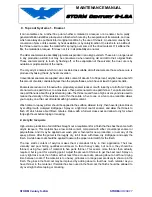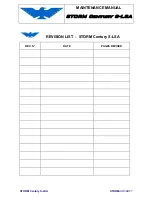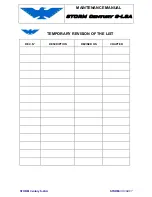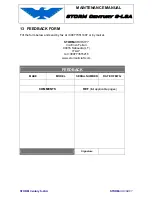
MAINTENANCE MANUAL
STORM Century S-LSA
STORM Century S-LSA
STORMAIRCRAFT
properly converted wash primer will not be damaged by the paint stripper; it can re-main on the finish
until the polyurethane has completely puckered up or lifted before flushing off the stripper and paint
residue.
No prepared paint remover should be used on air-craft fabric or be allowed to come in contact with any
fiberglass reinforced parts such as radomes, radio antenna, or any component such as fiberglass-
reinforced wheel pants or wing tips. The active agents will attack and soften the binder in these parts.
CAUTION:
Any time you use a paint stripper, always wear protective goggles and rubber gloves. If
any stripper is splashed on your skin, wash it off immediately with water; and if any comes in contact
with your eyes, flood them repeatedly with water and CALL A PHYSICIAN.
2. Corrosion
removal
Any trace of the white powder which indicates corrosion must be critically examined.Corrosion of
aluminum or magnesium is essentially an electrochemical process in which the alloying agents in the
metal have reacted with moisture and/or oxygen on the surface to form an electrical battery and
generate a flow of electrons. The chemical action which caused these electrons to flow has converted
some of the metal into a porous salt which has no physical strength. Corrosion, once it starts, will often
continue until the skin or component is damaged beyond repair. The manual entitled
Aircraft Corrosion
Control
deals in detail with this problem—its cause and correction. If corrosion is found on the airplane
you have stripped, it is recommended that you consult this book.
If corrosion is found, every trace must be re-moved with fine sandpaper (no emery), aluminum wool, or
a nylon scrubber.
CAUTION:
Never use steel wool or a steel brush to remove corrosion from aluminum, as tiny bits of
steel will embed in the aluminum and cause much worse corrosion than you had
to begin with.
3. Conversion coatings
After every trace of corrosion has been removed, it must be determined whether or not the structure
has been damaged enough to require replacement or reinforcement. If the damage is relatively
superficial, the metal may be treated with a con-version coating. This is essentially a phosphoric acid
etchant which reacts with the metal to convert into a phosphate film over the metal and prevents
recurrence of the corrosion.
The acid content of these materials is so low that a thorough flushing of the surface with water followed
by air drying is sufficient to remove all traces of any unconverted acid. The extremely thin phosphate
film left by this conversion provides a good bond for subsequent primers or top-coats.
Conversion coatings are applied to surfaces of new clad aluminum to microscopically
roughen and prepare them so the additional coats will adhere.
4. Corrosion protection for dissimilar metals
Any time aluminum and magnesium are to be joined, the magnesium should be treated with a
chromic acid brush-on treatment similar to the Dow 19 treatment. Mix 1-1/3 ounces of chromic
anhydride (CrO3) with one ounce of calcium sulfate (CaSO4) in enough water to make one
gallon. Brush this on the magnesium and let it stay for one to three minutes and rinse it off
with cold water. After it is thoroughly dry, treat the surface with a wash primer, and after this
has cured, coat it with an epoxy primer.
Содержание Century S-LSA
Страница 13: ...MAINTENANCE MANUAL STORM Century S LSA STORM Century S LSA STORMAIRCRAFT 1 4 ENGINE SPECIFICATIONS ...
Страница 74: ...MAINTENANCE MANUAL STORM Century S LSA STORM Century S LSA STORMAIRCRAFT Fig 3 24 Fig 3 25 ...
Страница 114: ...MAINTENANCE MANUAL STORM Century S LSA STORM Century S LSA STORMAIRCRAFT CHAPTER 9 ELECTRICAL SYSTEM DIAGRAM Fig 9 1 ...
Страница 129: ...MAINTENANCE MANUAL STORM Century S LSA STORM Century S LSA STORMAIRCRAFT 10 7 3 FIREWALL ELECTRIC PANEL Fig 10 7 ...







































